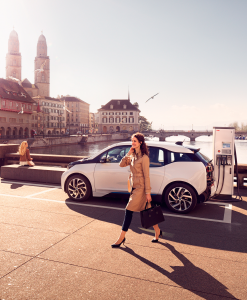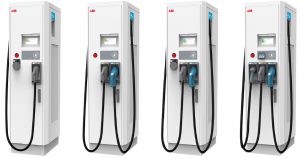There are two types of battery charging: alternating current (AC) and direct current (DC). When charging with alternating current, the AC/DC converter is located in the electric vehicle, where alternating current is converted into direct current needed to charge the batteries. Two types of connectors are used for this purpose:
– Type 1 AC – it is possible to charge with single- or three-phase current, provided that the current intensity will not exceed 16A. The solution is not very popular in Europe, mainly used in the United States and Japan. Of the available contacts, two are used for communication purposes, and the remaining ones are used for power supply – for single-phase chargers, these are L1, N and PE; for 3-phase chargers L1, L2 and PE.

– Type 2 AC – a popular connector in Europe, compliant with the IEC 62196-2 standard. The maximum current required by technical standards cannot be higher than 32A. The plug has seven contacts, five of which are used to charge the electric vehicle and the rest are used for communication.

InDCcharging, AC/DC current conversion takes place in the charger, hence direct current is supplied directly to the electric vehicle. Typical connectors for DC chargers are:
– CCS Combo 2 – widely used in Europe, guaranteeing durability for operation with a maximum charging power of up to 500kW. This connector differs from the TYPE 2 (AC) connector in that it additionally contains an additional lower module supplying direct current with polarization “+” “-”

– CHAdeMO – Japanese standard for DC charging of electric vehicles. The distinguishing feature of this standard is the possibility of bidirectional energy flow between the charger and the electric vehicle. The maximum charging current for CHAdeMO is 125A, while for the newer version of CHAdeMO 1.2 – 200A.


According to the table above,ACchargers are most often used in single-family homes, workplaces, hotels, in places where the charging time is 2-16 hours (e.g. overnight charging).
DC chargers with a power of 20-25kW, which will charge the battery in 1-3 hours, are installed in parking lots, student towns or in locations with little available power.
Fast DC charging stations up to 50kW are successfully selected for parking lots in shopping malls, restaurants and gas stations where travelers leave their vehicle for a short period of time.
The last type of chargers in our division arehigh-power DC chargerswith a power of over 350kW, designed for locations such as highways, bypasses, and gas stations. Such high power guarantees charging the vehicle to 80% of the battery capacity in less than 30 minutes.

Sources:
https://www.udt.gov.pl/typy-ladowania
Send inquiry


 en
en  PL
PL  DE
DE  LT
LT  SV
SV  FR
FR  ES
ES  HU
HU  NO
NO  DK
DK  FI
FI  RU
RU 

